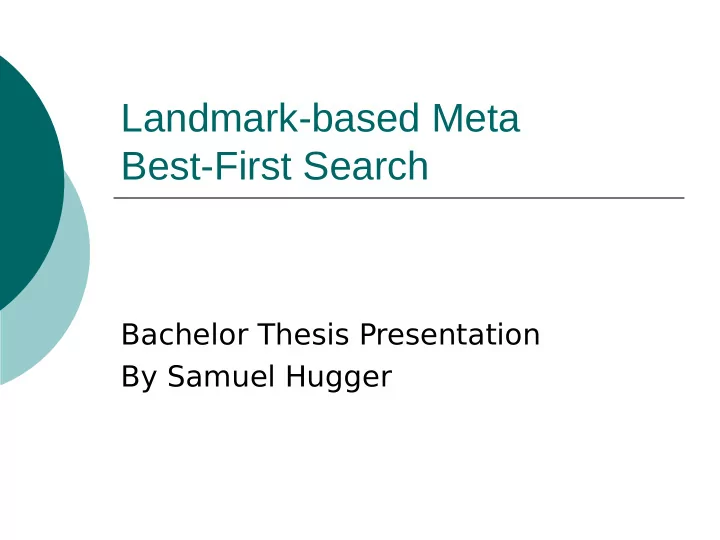

Landmark-based Meta Best-First Search Bachelor Thesis Presentation By Samuel Hugger
STRIPS Planning Model States Set of atoms True or False Actions Preconditions Add-efgects Delete-efgects
STRIPS Planning Model Planning T ask States Actions Initial state Goal condition Solution plan Sequence of actions from initial state to goal
Landmarks Landmarks are facts that have to be true at some point of every solution plan necessary conditions for reaching any goal We consider causal landmarks which correspond to atoms (Zhu & Givan, 2003)
Landmark-based Search Successful: landmarks in heuristic functions LM-count heuristic LM-cut heuristic Not as successful: landmarks in meta- search – lack of completeness Landmark-based Meta Best-First Search Algorithm (LMBFS), Vernhes et al., 2013
Landmark-based Meta-Search The idea: Divide the planning task into subtasks Each subtask‘s goal is the achievement of a landmark Subtask ordering?
Landmark ordering A bunch of landmarks Order them in a way that is benefjtial to reaching the goal of the planning task
Precedence Relation We order our landmarks based on the precedence relation.
Landmark graph The resulting landmark graph is oriented towards solution plans Good starting points for the search:
Landmark graph Root landmarks in this graph: Node A is a root landmark – it is likely to be achieved early in every solution plan
Metanodes The subtask associated to a metanode m has the landmark l as goal
Subtask action restriction Actions must either or: achieve l not achieve any root landmarks This focuses the subsearch on l Run subsearch – if successful, expand the associated metanode
Expansion of Metanodes Achieved landmarks are removed from the landmark graph New metanodes are generated and added to the open list
Metanode Generation - nextLM A – expanded metanode E, D – generated metanodes
Metanode Generation - deleteLM No subsearch is run on A – A is removed from the landmark graph E,D – generated metanodes
Completeness
Best-first Search - Heuristics LMBFS uses heuristics to select the most promising metanode in each iteration This heuristic works well with LMBFS, as the set of achieved landmarks is already saved in each metanode
The LMBFS Algorithm
LMBFS Evaluation LMBFS has been implemented in Fast Downward Eager-Greedy search as subplanner Eager-Greedy search for comparison Experiments have been run on the Maia Cluster, using downward-lab
LMBFS Evaluation
LMBFS Evaluation
LMBFS Evaluation
LMBFS Evaluation
LMBFS Evaluation This implementation of LMBFS is at least a few optimizations away from being competitive with EagerGreedy search LMBFS implemented by Vernhes et al. in 2003 has been shown to be competitive with the LAMA-11 planner on 14 IPC- domains
Conclusion Landmark-based Meta Best-First Search represents a successful realization of landmarks as an efgective tool in a meta- search environment Meta-search is a highly fmexible framework with a number of unexplored areas – new successor functions, dynamic successor function choice, the interplay of meta- search and subsearch, and many more
Bibliography
Recommend
More recommend